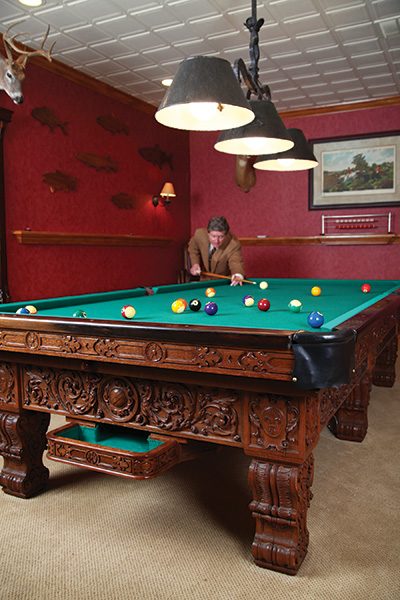
“I’m only coming over if I can play on Woodrow Wilson’s pool table.”
I’ve grown accustomed to friends telling me that—and it’s my own fault. For the last six years, I’ve helped spread the word that my parents’ antique pool table was once the plaything of the 28th president. It certainly looks presidential. A jaw-dropping, 10-foot-long Brunswick with fleur-de-lis carvings on its base, the table was crafted in 1915. Our part in its story begins in 2006, when my dad decided to transform our unfinished Morristown basement into his own lair, complete with bar, mounted animal heads, a vent for cigar smoking, and a pool table.
In the Morris NewsBee, he spotted an ad for an antique billiard set. It came with 16 balls, 12 cue sticks, a cue stand, five bar stools, three observing chairs, an overhead lamp and a rack of ivory scoring beads. The seller was offering it for what seemed a fraction of its worth. During the transaction, he mentioned that the table might have belonged to Woodrow Wilson.
With the centennial of Wilson’s first presidential inauguration approaching this month, I decided to learn more about the table’s origins. A native of Virginia, Wilson served as president of Princeton University from 1902 to 1910, as governor of New Jersey from 1911 to 1913, and as U.S. president for two terms, bracketing World War I.
Among other proclivities, Wilson liked to shoot pool. My dad learned that Wilson played on a table in Prospect House at Princeton, in the Map Room at the White House and at the Shadow Lawn estate in West Long Branch, where he summered as president in 1916.
With help from the Monmouth University Library, we received images from a 1940 auction catalog of items from Shadow Lawn, including a billiard set that matched ours. My dad even found a photograph of the Shadow Lawn billiard room—another perfect match. Convinced we had the real thing, we let the world know that our new acquisition had presidential bloodlines.
As word spread, we began to accumulate Wilson paraphernalia. One friend framed a portrait of the president to hang over the bar’s fridge. A neighbor gave us an original Wilson calling card that he acquired from a collector in Princeton. At a party, a rowdy guest accused my family of being racist because the president—a Southerner—had infamously supported Jim Crow laws.
Recently, while further researching our table, I encountered this bombshell: The West Long Branch mansion where Wilson stayed in 1916 burned down in 1927, reducing the pool table that the president played on and all the rest of the home’s contents to smoldering ash.
So what was the true provenance of our billiard set?
Enter one Hubert Parson. The president of the Woolworth’s discount-store chain from 1919 to 1932, Parson rebuilt Shadow Lawn in 1929 on its old site. The Great Depression later caught up with him, and his widow was forced to auction off the family’s lavish furnishings—including their 1915 Brunswick pool table.
Today the second Shadow Lawn, renamed Woodrow Wilson Hall, is part of Monmouth University. In our Morristown basement, the president’s portrait stares down at Hubert Parson’s billiards set. I trust old Woodrow doesn’t mind too much, but my dad has yet to recover from our family miscue.
